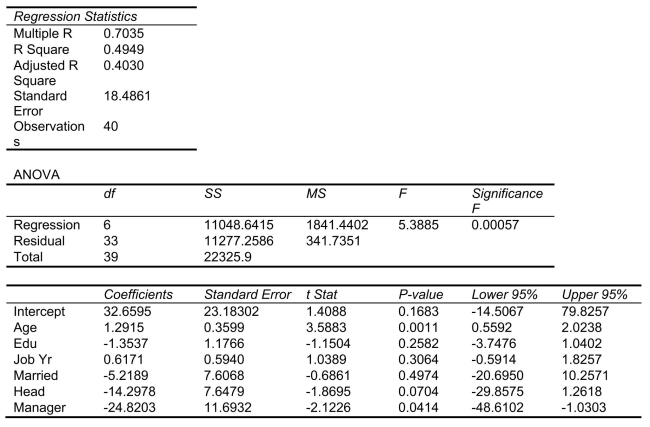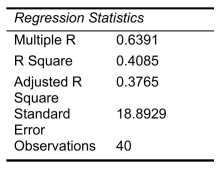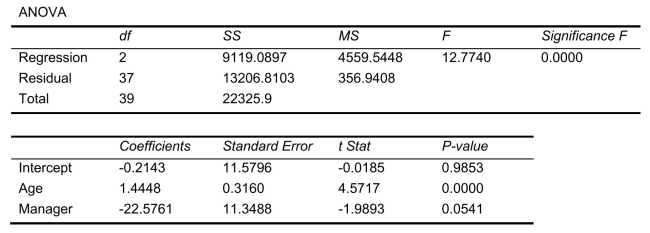SCENARIO 18-10 Given below are results from the regression analysis where the dependent variable is the number of weeks a worker is unemployed due to a layoff (Unemploy)and the independent variables are the age of the worker (Age), the number of years of education received (Edu), the number of years at the previous job (Job Yr), a dummy variable for marital status (Married: 1 = married, 0 = otherwise), a dummy variable for head of household (Head: 1 = yes, 0 = no)and a dummy variable for management position (Manager: 1 = yes, 0 = no).We shall call this Model 1.The coefficient of partial determination  of each of the 6 predictors are, respectively, 0.2807, 0.0386, 0.0317, 0.0141, 0.0958, and 0.1201.
of each of the 6 predictors are, respectively, 0.2807, 0.0386, 0.0317, 0.0141, 0.0958, and 0.1201.  Model 2 is the regression analysis where the dependent variable is Unemploy and the independent variables are Age and Manager.The results of the regression analysis are given below:
Model 2 is the regression analysis where the dependent variable is Unemploy and the independent variables are Age and Manager.The results of the regression analysis are given below: 

-Referring to Scenario 18-10 and using both Model 1 and Model 2, there is insufficient evidence to conclude that the independent variables that are not significant individually are significant as a group in explaining the variation in the dependent variable at a 5% level of significance?
Definitions:
Activity Measure
A metric used in activity-based costing to assess the extent of activity that incurs costs, aiding in more accurate cost allocation.
Spending Variances
The difference between the actual amount spent and the budgeted amount for various expenses.
Meals
Expenses for food consumed, often related to business meetings or employee welfare.
Kitchen Operations
The activities and tasks related to managing and running a kitchen in a restaurant or hotel, including food preparation and service.
Q1: Referring to Scenario 19-8, an <img src="https://d2lvgg3v3hfg70.cloudfront.net/TB8562/.jpg"
Q12: Referring to Scenario 19-10, construct a c
Q19: The SS method establishes ways to organize
Q20: Referring to Scenario 18-8, there is sufficient
Q50: Referring to Scenario 19-9, an <img src="https://d2lvgg3v3hfg70.cloudfront.net/TB8562/.jpg"
Q61: Referring to Scenario 19-5, the best estimate
Q78: Referring to Scenario 20-2, what is the
Q162: Referring to Scenario 16-13, you can reject
Q244: Referring to Scenario 18-10 Model 1, which
Q273: Data on the amount of money made